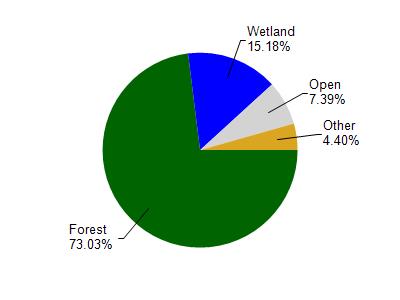Burnett
No
No
No
Fish and Aquatic Life
Overview
Rooney Lake, in the Lower Namekagon River Watershed, is a 329.47 acre lake that falls in Burnett County. This lake is managed for fishing and swimming and is currently not considered impaired.
Date 2011
Author Aquatic Biologist
Historical Description
This 322 acre seepage lake has an active lake association and a self-help volunteer has been
collecting water clarity data since 1987. This lake group has also contracted with U. W. Stevens
Point for water chemistry analysis for the past three years. Rooney Lake has a rather sparse
fishery but excellent water quality. A lake management plan stressing the protection of water
quality would be an excellent goal for this lake group.
Date 1992
Author Surface Water Inventory Of Wisconsin
Historical Description
Source: 1966, Surface Water Resources of Burnett County Rooney Lake, T40N, R14W, Sections 10, 11, 15 Surface Acres = 330.5, Maximum Depth = 29 feet, M.P.A. = 25 ppm, Secchi Disk = 12 feet A soft water, seepage lake, landlocked and having a fish population composed of northern pike, walleye, largemouth bass, bluegill, perch, rock bass, pumpkinseed, bullhead, white sucker and common shiner. Slow-growing bluegill are a management problem. The lakeshore is predominantly upland except for a small area of tag alder and fresh meadow marsh, mostly along the west shore, which provides some habitat for nesting mallards, blue-winged teal, wood ducks, ring-necked ducks and loons. Spring and fall migrant diving ducks also use the lake. The only access is a private one off the town road on the south side. There is 0.04 miles of public frontage which includes three undeveloped platted accesses and an undeveloped platted park. Private development consists of one church camp and 34 cottages and dwellings.
Date 1966
Author Surface Water Inventory Of Wisconsin
General Condition
Rooney Lake (2493100) was assessed during the 2016 listing cycle; total phosphorus and chlorophyll sample data were clearly below 2016 WisCALM listing thresholds for the Recreation use and Fish and Aquatic Life use. This water is meeting these designated uses and is not considered impaired.
Date 2015
Author Ashley Beranek
Condition
Wisconsin has over 84,000 miles of streams, 15,000 lakes and milllions of acres of wetlands. Assessing the condition of this vast amount of water is challenging. The state's water monitoring program uses a media-based, cross-program approach to analyze water condition. An updated monitoring strategy (2015-2020) is now available. Compliance with Clean Water Act fishable, swimmable standards are located in the Executive Summary of Water Condition in 2018. See also the 'monitoring and projects' tab.
Reports
Recommendations
Monitor Water Quality or Sediment
Upon further review there isn't enough data each of the five years to justify listing. Need more data before listing. AU: ; Station ID:
Management Goals
Wisconsin's Water Quality Standards provide qualitative and quantitative goals for waters that are protective of Fishable, Swimmable conditions [Learn more]. Waters that do not meet water quality standards are considered impaired and restoration actions are planned and carried out until the water is once again fishable and swimmable
Management goals can include creation or implementation of a Total Maximum Daily Load analysis, a Nine Key Element Plan, or other restoration work, education and outreach and more. If specific recommendations exist for this water, they will be displayed below online.
Monitoring
Monitoring the condition of a river, stream, or lake includes gathering physical, chemical, biological, and habitat data. Comprehensive studies often gather all these parameters in great detail, while lighter assessment events will involve sampling physical, chemical and biological data such as macroinvertebrates. Aquatic macroinvertebrates and fish communities integrate watershed or catchment condition, providing great insight into overall ecosystem health. Chemical and habitat parameters tell researchers more about human induced problems including contaminated runoff, point source dischargers, or habitat issues that foster or limit the potential of aquatic communities to thrive in a given area. Wisconsin's Water Monitoring Strategy was recenty updated.
Grants and Management Projects
Monitoring Projects
| WBIC | Official Waterbody Name | Station ID | Station Name | Earliest Fieldwork Date | Latest Fieldwork Date | View Station | View Data |
|---|
| 2493100 | Rooney Lake | 10001651 | Rooney Lake | 9/5/2000 | 6/11/2025 | Map | Data |
| 2493100 | Rooney Lake | 073042 | Rooney Lake - West Bay-Site B | 5/25/1988 | 5/29/2021 | Map | Data |
| 2493100 | Rooney Lake | 073041 | Rooney Lake - East-Site A-Main Basin | 6/4/1988 | 9/3/2025 | Map | Data |
| 2493100 | Rooney Lake | 10018467 | Rooney Lake -- Access | 7/7/2005 | 9/20/2024 | Map | Data |
|

Watershed Characteristics
Rooney Lake is located in the Lower Namekagon River watershed which is 239.34 mi². Land use in the watershed is primarily forest (73.10%), wetland (15.20%) and a mix of open (7.40%) and other uses (4.40%). This watershed has 172.53 stream miles, 12,590.30 lake acres and 21,781.64 wetland acres.
Nonpoint Source Characteristics
This watershed is ranked Not Ranked for runoff impacts on streams, Not Ranked for runoff impacts on lakes and Low for runoff impacts on groundwater and therefore has an overall rank of Low. This value can be used in ranking the watershed or individual waterbodies for grant funding under state and county programs.However, all waters are affected by diffuse pollutant sources regardless of initial water quality. Applications for specific runoff projects under state or county grant programs may be pursued. For more information, go to surface water program grants.